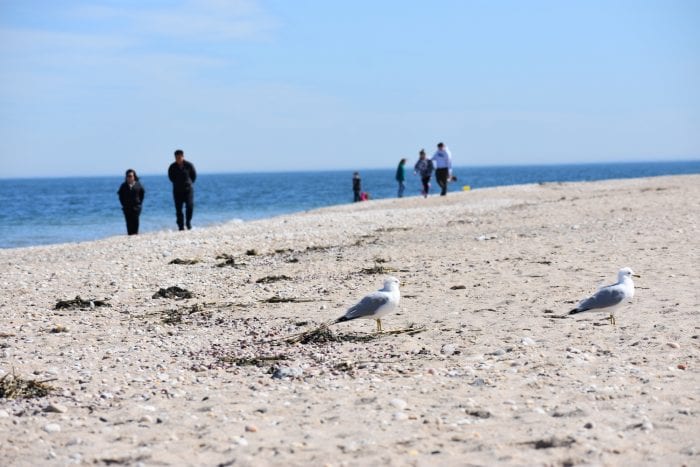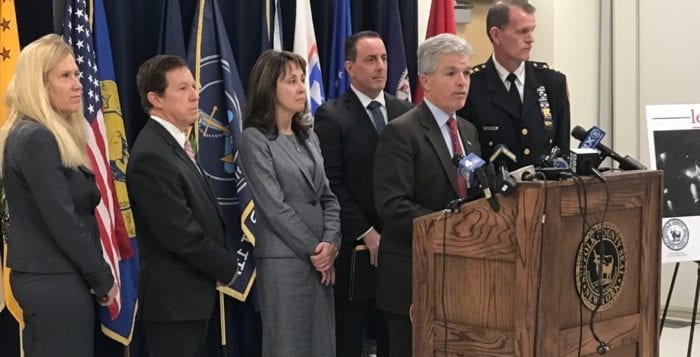By Daniel Dunaief
Brookhaven National Laboratory is putting its considerable human and technical resources behind the global effort to combat the coronavirus.
John Hill, the director of the National Synchrotron Lightsource II, is leading a working group to coordinate the lab’s COVID-19 science and technology initiatives. He is also working on a team to coordinate COVID-19 research across all the Department of Energy labs.
“We are proud that the tools we built at BNL, which include the NSLS II, which took 10 years to build and cost about a billion dollars,” will contribute to the public health effort, Hill said. “We feel that science will solve this problem, and hopefully soon. It’s great that BNL is a part of that fight.”
In addition to using high-technology equipment like the NSLS II to study the atomic structure of the virus and any possible treatments or vaccines, BNL is also engaging a team led by Kerstin Kleese van Dam, who is the director of BNL’s Computational Science Initiative.
According to Hill, the combination of the physical experiments and the computing expertise will provide a feedback loop that informs the efforts with each team. Kleese van Dam’s team is using supercomputers to run simulated experiments, matching up the atomic structure of the viral proteins with any potential drugs or small molecules that might interfere with its self-copying and life-destroying efforts.
The computer simulations will enable researchers to narrow down the list of potential drug candidates to a more manageable number. Experimental scientists can then test the most likely treatments the computer helped select.
Across the world, the scale of the science to which BNL is contributing is even larger than the Manhattan Project that led to the creation of the atomic bomb during World War II, said Hill.
In just three months since scientists in China produced the genetic sequence of the coronavirus, researchers around the world have produced over 15,000 research articles, some of which have been published in scientific journals, while researchers have self-published others to share their findings in real time.
Working with computer scientists from different fields at BNL, Kleese van Dam is helping researchers screen through the abundant current research on COVID-19. The number of papers is “accelerating at a rate no one can read,” Hill explained.
Kleese van Dam and four of her scientists are setting up a natural language processing interface so scientists can type in what they want to find, such as a protein binding with a specific complex, and put it into a search engine. She is working on an initial service that she hopes to expand. Additionally, the computer science team is planning to start a project to look at epidemiological data to determine how various people might react to different treatment.
Kleese van Dam and her team are also working to build an archive in the United States that they hope will host at least the results of the Department of Energy funded projects in medical therapeutics. “[We are] convinced that this would provide a much better starting point for future outbreaks, as well as providing a near term clearing house of results,” she explained in an email.
As for the work at the synchrotron, Hill said that the high-energy x-rays can determine the specific atomic configuration of proteins in the virus.
The NSLS II, which was designed to study the structure of batteries, geology and plant cells, among other objects, can look at “small protein crystals better than anywhere else in the world.”
The virus relies on a docking mechanism that allows it to enter a cell and then insert its malevolent RNA to disrupt the cell’s normal function. Understanding how the pieces come together physically can allow researchers to look for small molecules or approved drugs that could interfere with the virus.
One of the many advantages of the synchrotron over protein crystallography is that the NSLS II doesn’t need as many copies of proteins to determine their atomic structure. Hill said protein crystallography needs samples that are about 100 to 200 microns in size, which is about the width of a human hair, which can take weeks to months to years to grow. This is a “bottleneck in the whole process” of solving protein structure, he said.
On the other hand, the NSLS II only requires samples of about a micron in size. This “greatly speeds up the process,” he added. Two different groups of researchers, from the pharmaceutical industry and from academia and national labs, are conducting experiments on the NSLS II.
Hill said he was receiving viral proteins scientists believe will bind with the virus from collaborators in the United Kingdom. The scientific process is as quick and collaborative as it’s ever been among researchers, he said. The proteins arrived recently.
That collaborative process would have “taken months to set up under normal circumstances,” Hill said. Instead, it only took a few days.
At the same time, BNL is constructing a cryo-electron microscope, which doesn’t have the same resolution as the NSLS II, but does not need crystals and can study individual proteins. Researchers need about 10,000 of them and can average the images together. The resolution is five to 10 times worse than x-rays.
BNL is accelerating the construction of the cryo EM and hope to have the first beam in mid-May. Commissioning will take some extra time, Hill said. The first structure of the coronavirus spike protein was determined by using an electron microscope.
For Hill and Kleese van Dam, who each have dedicated much of their time to these efforts, the opportunity to contribute to a project that could have implications for a public that is battling this disease is rewarding and offers reasons for optimism.
“To be able to help at such a scale is indeed humbling and gratifying,” said Kleese van Dam. “Science is going to solve this problem,” added Hill. “That gives me comfort.”















